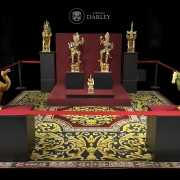2022年 12 月 29 日 " 亞洲藝術品拍賣 "
Sancai glazed pottery figure 'Archer on horseback', Tang dynasty (618 - 906)
A figure modelled in kaolin ware and decorated in amber, green and cream-coloured 'sancai' glaze (三彩) and polychrome. The body of the animal is hollow and has an opening in the lower part of the belly.
It depicts a rider mounted on horseback, astride a saddle, with his hands curled up as if grasping the reins, or holding a bow, which is not present. Weapons are not preserved in these figures because they were probably made of wood. The rider's head is tilted in the opposite direction to the horse's and both are expressed with their mouths open. This warrior wears a long jacket, tied at the waist, and trousers. The head and hands are covered with engobe, partially worn, with the details of the face and hair highlighted in black. The figure is modelled in detail and the features are perfectly distinguishable.
The three-colour 'sancai' glaze covers the saddle, which has the three colours intertwined in different decorative patterns. The rest of the horse is glazed in amber, as is the rider's upper piece of clothing. In contrast, the breeches, mane and lower part of the horse are covered in cream. The colours of the glaze are slipped and intermingled from the top to the base, leaving part of the base uncovered. Such figures are called mingqi (shiny objects) in Chinese and were intended to serve and keep the deceased company in the afterlife.
Height: 36 cm; Length: 42.5 cm.
Its state of preservation is exceptional, considering its age.
Documentation:
It is accompanied by a report and "Thermoluminescence Test" carried out by the TL ASA Expertises Francine Maurer Laboratory. Report no.: 12.18.25 - TL 102.214, year 2001. The result confirms, from the extraction of material from the piece, compatibility with ceramic materials fired in Tang dynasty period.
Provenance:
Spanish private collection.
This important private collection comes from a successful national and international construction and investment businessman who lived in different parts of Spain and the South of France. This part of the collection, exhibited exclusively for the first time at auction, focuses on Chinese ceramics from the Tang dynasty and is a collection of museum quality pieces. The family's tradition of travel dates back to the success of an ancestor who in the 1930s travelled to Manila, Shanghai, Cairo, Havana, etc., practising the sport of "cesta punta", and in particular, motivated by an interest in discovering different cultures, which led them to build up a large collection. In general, their interest in art is such that their collection includes pieces of both Asian and European origin.
The acquisition of the collection began in the 1990s and was built up during years of study in Madrid and on various trips to Paris, New York, Hong Kong, Spain and Germany; at reputable antique dealers such as "Arch Angel" in Hong Kong and international auctions such as Nagel. To this end, specialists have also collaborated in the selection, study and verification of the pieces, as can be seen in the accompanying documentation: invoices, studies and reports.
Additional information:
The function of these figures was to protect the tombs and accompany the deceased, and they were endowed with visual qualities for this purpose. The first such figures were seen in the tombs of Li Feng, Prince of Guo (622-675). Large 'sancai' figures of better quality were included in the tombs of royalty and nobility, both in the Chang'an capital of the time and in the city of Luoyang. Their production declined in the late 8th century after the An Lushan rebellion (AD 755-63) due to the decline of the dynasty.
They are decorated with brightly coloured glazes that can be seen on many Tang-era wares from the 7th century onwards. The type of glaze was called "Sancai" (三彩) because of the use of three low-temperature firing colours. They are coloured by metallic oxides of copper, iron, cobalt and manganese. They are an evolution of the tradition of Han and Wei single-colour ceramics. The material used to make these ceramics is kaolin with fine white texture and glossy glazes, representing the peak of the development of coloured glazed ceramics in China. The result is a magnificent and dazzling artistic effect. An example would be the Luoyang Museum's figure set "洛陽博物館" and the Shaanxi History Museum's "陕西历史博物馆
The theme of figures of horsemen on horseback is emblematic of funerary sculpture from the early 8th century, during the height of the Tang dynasty. The number of people allowed to own horses was limited, according to the sumptuary laws, so it was a symbol of wealth. Among the types of horses there were also distinctions, the most demanded type of horses were bred in the western kingdom of Ferghana and were sent directly to the emperor.
































